The SilverStone Nightjar NJ450-SXL 450W SFX PSU Review: Passive Excellence
by E. Fylladitakis on April 4, 2019 8:00 AM EST- Posted in
- Cases/Cooling/PSUs
- PSUs
- SilverStone
- Passive Cooling
- SFX
- SFX-L
- Passive
External Appearance
SilverStone’s Nightjar NJ450-SXL definitely is a unique PSU in both practical and aesthetic terms. Its chassis is essentially a large heatsink and there are no air vents anywhere to be found. The chassis is 130 mm long, which does not fit the standard 125 × 63.5 × 100 mm / 4.92 × 2.5 × 3.94 in (W×H×D) SFX form factor dimensions. SilverStone designates these PSUs as “SFX-L” units and caution is advised as they could be incompatible with compact cases designed to just fit a regular SFX PSU. It also tips the scales at slightly over 1.5 kg, making it significantly heavier than any similarly-sized conventional PSU.
As the PSU relies on natural convection for cooling, the designer had to convert its sides, top, and bottom into aluminum heatsinks with adequate mass and surface area. Instead of using a fan to remove thermal energy from the unit’s internal heatsinks and transfer it to the outside of the case, the internal heatsinks are now attached to the comparatively massive chassis heatsink and the energy is being dissipated directly to the surrounding air - this air, however, will still be inside the system’s case.
In order to leave the heatsinks unobstructed, the designer moved the sticker with the unit’s electrical specifications and certifications at the rear side of the PSU, next to the on/off switch and the AC cable receptacle, on the area that is normally used for the air exhaust vents. The front side holds the connectors for the modular cables. Most of the connectors are black, with the exception of the PCI Express device connectors, which are blue. SilverStone also placed small plastic caps on most of the connectors, excepting the 24-pin cable connector that will always be populated anyway. A small legend on a sticker below the connectors indicates where each connector goes. An interesting observation here is that the NJ450-SXL offers four PCI Express device connectors, suggesting that it can be used to power multi-GPU systems, even though it clearly is unwise to try and power two top-tier graphics chipsets with such a low power output.
Internal Design
There is no fan to talk about in the NJ450-SXL, so we jump right to the OEM of the platform, which is Enhance Electronics. Enhance is not particularly popular amongst enthusiasts because their top-tier designs are frequently outperformed (or outpriced) by other OEMs but their products undeniably are of high quality and reliable.
Internally, the SilverStone Nightjar NJ450-SXL is not in any way special when compared to typical PSUs, with the exception of the strange-looking heatsinks. Unlike the heatsinks we normally find in regular air-cooled PSUs, the internal heatsinks of the Nightjar NJ450-SXL are thin and designed so as to have ample contact surface with the exterior heatsinks of the power supply. As they have very little mass, the internal heatsinks store very little thermal energy and quickly transfer it to the greatly larger exterior of the PSU, acting much like solid heat pipes.
The filtering stage is found on a daughterboard that is placed against the rear wall of the unit, where the sticker with its electrical specifications is. Enhance is a bit generous when it comes to filtering, as we counted two more X capacitors than usual, i.e. four Y capacitors, four X capacitors, and two filtering inductors. There are two rectifying bridges, both attached to a small heatsink that is in contact with the chassis. The rectifying bridges are greatly oversized and can handle the load of even >1 kW PSUs, so it is highly unlikely they will be getting even lukewarm inside the Nightjar NJ450-SXL.
Enhance took a slightly wild approach with the positioning of the two primary inversion MOSFETs that form the unit’s half-bridge primary stage. The designer moved them on a vertical daughterboard near the edge of the unit, in direct contact with the unit’s side cover. As these are perhaps the hottest part inside modern PSUs, the designer most probably wanted to ensure the best possible heat transfer from them to the unit’s exterior. The primary APFC capacitor is rated at 450V/390μF and made by Hitachi.
All of the secondary side MOSFETs that generate the 12V line are placed on the underside of the main PCB, in direct contact (via a thermal pad, of course) with the large heatsink cover of the PSU. A vertical PCB near the left edge of the PSU holds the DC-to-DC converters for the 5V and 3.3V voltage line. The few electrolytic capacitors on the secondary side are made by Unicon, a Japanese company that we rarely see supplying products for PC PSUs. The solid-state capacitors are supplied by Nichicon.



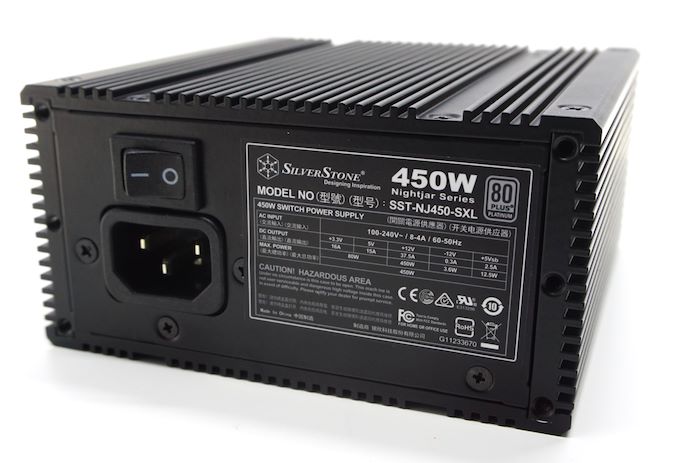
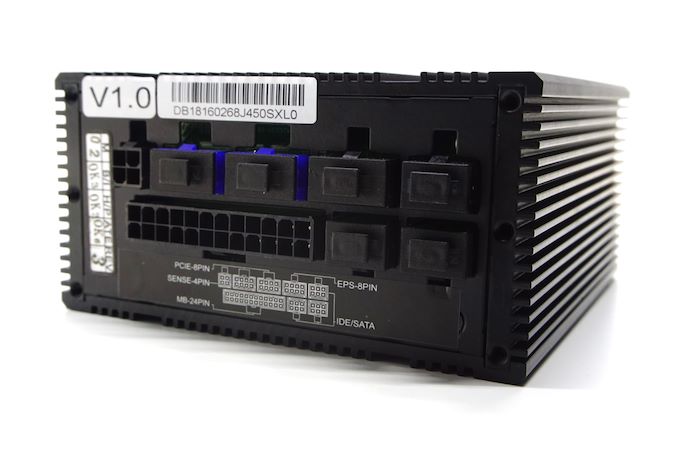
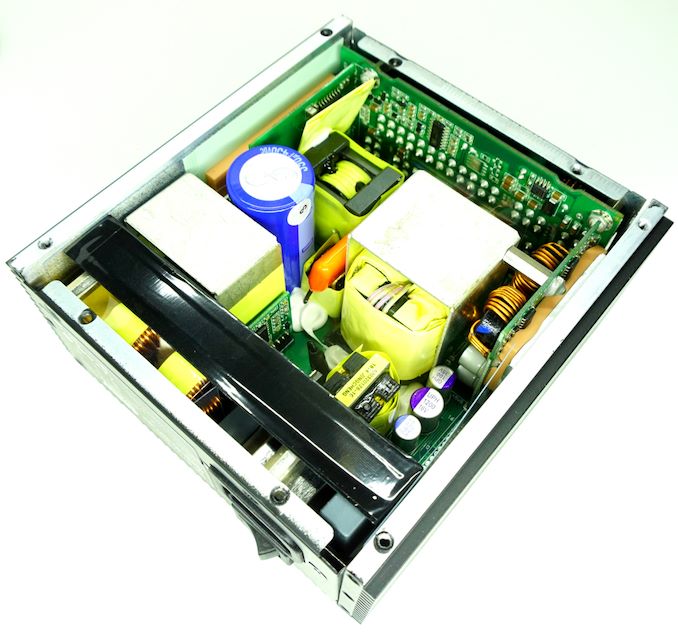
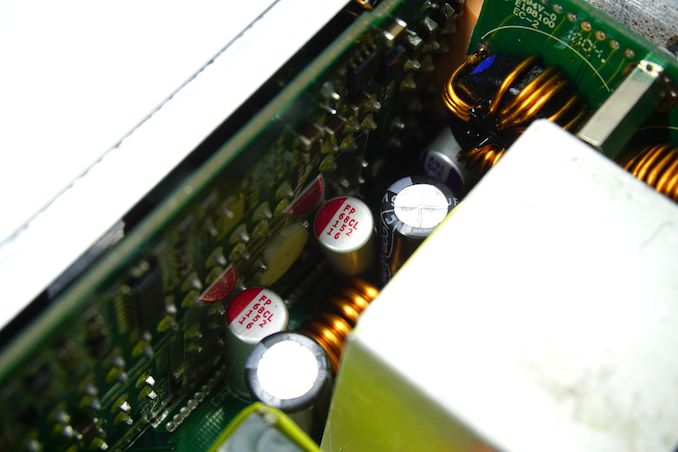
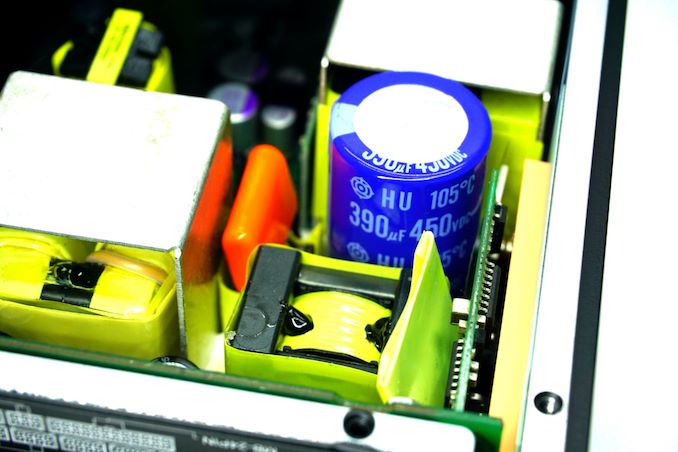
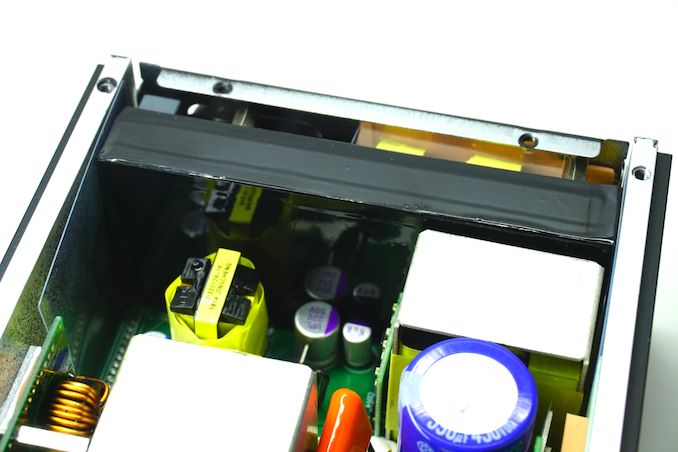








25 Comments
View All Comments
Death666Angel - Monday, April 8, 2019 - link
I have 2 monitors with interal power supplies that are caged by metal sheets and the only gap in that sheet are the power and display plugs. I can hear the whining noise very easily, once I move my head behind the monitor. In front of it, there is no noticeable noise (likely blocked by the display itself). But it is not that cut and dry.nagi603 - Monday, April 8, 2019 - link
Yeah, metal sheets are not good noise dampeners :DIcehawk - Thursday, April 4, 2019 - link
I have had one of these running 24-7 in my rig for about 7 years with no problems, have a higher wattage passive in my new box too. My PCs are very quiet with no PSU fans or mech HDDs. These are built to a high quality compared to a typical $50 PSU and is reflected in their cost.R3MF - Thursday, April 4, 2019 - link
i have a ~13 year old Nightjar 300W still running fine.Samus - Friday, April 5, 2019 - link
I've used a Seasonic X400 passive cooled PSU in my media PC (Silverstone ML03 case) for around 10 years. No problems at all. It started as an Intel i5-650 with a GeForce 430, then graduated to an AMD A10-9700, and is currently an i3-8100 still with the same GeForce 430 I used a decade ago because to me it makes a virtually perfect HTPC video card.The entire PC has always been passively cooled. A voltmod and BIOS flash to the EVGA GeForce 430 reduced its clock speed to 500MHz (1000MHz shader) and basically cut its TDP in half, allowing for a passive heatsink to be more than effective, and the CPU has used a NoFan CR-80eh cooler for most of this units life. The old Lynnfield CPU I used a Scythe Kozuti that needed modification to fit the motherboard\case by bending some heatpipes and the attached fins, which I broke removing it from the CPU when I upgraded (technically downgraded lol) the platform to an AMD A10. The A10 was a slower CPU but had much better thermal efficiency than the old i5, and the GPU was pretty good. The i3-8100 is absolutely perfect and the system has never run cooler. Total wall power draw during 1080p 24.976hz h264 video playback is 66 watts measured from a kill-a-watt and there are TWO SSD's and a 10TB HDD inside the case!
It's worth mentioning this is also my torrent PC so it is 24/7 albeit pretty low constant load.
All that said, the PSU and case have been through multiple generations of components.
DanNeely - Thursday, April 4, 2019 - link
As a general question, I'm wondering when we might start to see PSUs ship with only sata connector strings and a sata-molex adapter or two in the package similar to how the berg connector originally for the 3.5" floppy drive has been mostly done over the last decade.b1ghen - Thursday, April 4, 2019 - link
Probably never since the SATA connector isn't rated for enough current (1.5A I believe) and might melt if you hook up anything power hungry to the Molex in such a setup. A Molex can supply up to 13A i think. So a single Molex can supply 8x the current as a single SATA.daniel78R - Thursday, April 4, 2019 - link
I think S-ATA is 1.5A per pin, and if I remember well there are 3 pins for 3.3V, 3 for 5V and 3 for 12V, that would be 9.9w + 15w + 36w = 60.9V. Molex is 11A i think for 12V, 132w. However, the cables themselves are more important, also the specs of the PSU itself. I've seen PSUs with much less Amps per Molex or SATA rails. Also, I think some of my modular PSUs have the same port for SATA and Molex use on the PSU side.While Molex and Floppy connector might be needed for powering fans and such, I doubt you will ever use for powering anything close to 130w. AFAIK the most power hungry HDDs were about 10-12w
29a - Thursday, April 4, 2019 - link
Hopefully never. I'd much rather have them and not need them than need them and not have them.flyingpants265 - Tuesday, April 9, 2019 - link
What if they made them modular and let you select your own cables?